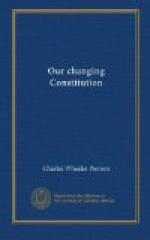(e) That other parts
of the Constitution—notably Article
I—express
the same limitation.
(f) That the existence of authority under Article V to enact ordinary laws regulating the conduct of private citizens under color of amendment, would be so in conflict with the fundamental principles and spirit of the Constitution that such a construction is not permissible.
[Footnote 1: For the Reporter’s Summary see 253 U.S., pp. 361-367.]
There were other arguments of a more technical character. Article V of the Constitution provides that the Congress shall propose amendments “whenever two-thirds of both Houses shall deem it necessary.” It was urged that this required the affirmative vote of two-thirds of the entire membership of both Houses, and that two-thirds of a quorum was not sufficient. It was also urged that the proposal was fatally defective because it did not on its face declare that both Houses deemed the amendment necessary. It was also argued that the amendment had not been effectively ratified in certain of the states where it had been approved by the state legislature (notably Ohio) because under the constitutions of those states it was subject to a referendum to the people before becoming effective. The Supreme Court of Ohio had so decided[1] and a referendum had actually been held in that state, resulting in a rejection of the amendment by popular vote. Various arguments were also advanced based on the puzzling phraseology of Section 2 of the amendment that “the Congress and the several States shall have concurrent power to enforce this article by appropriate legislation.” The eminent constitutional lawyer, W.D. Guthrie, addressed himself particularly to this phase of the controversy.[2] It was urged with much force that the effect of these words was to save the rights of the states, in respect of intrastate matters, by requiring their concurrence in any legislation of Congress regulating such matters.
[Footnote 1: See Hawke v. Smith, 253 U.S., 221.]
[Footnote 2: 253 U.S., pp. 368-380.]
All the arguments advanced were alike unavailing. The nine members of the Supreme Court were unanimous in sustaining the validity of the amendment, holding that it “by lawful proposal and ratification, has become a part of the Constitution, and must be respected and given effect the same as other provisions of that instrument."[1] The Court, however, adopted the very unusual course of deciding the various cases before it (affirming four, reversing one, and dismissing the original bills filed by the states of Rhode Island and New Jersey) without any written opinion. Speaking through Mr. Justice Van Devanter, the Court merely announced its conclusions. This was an unprecedented procedure in a case involving constitutional questions of such importance. It drew criticism from some of the members of the Court itself. Chief Justice White said:[2]




